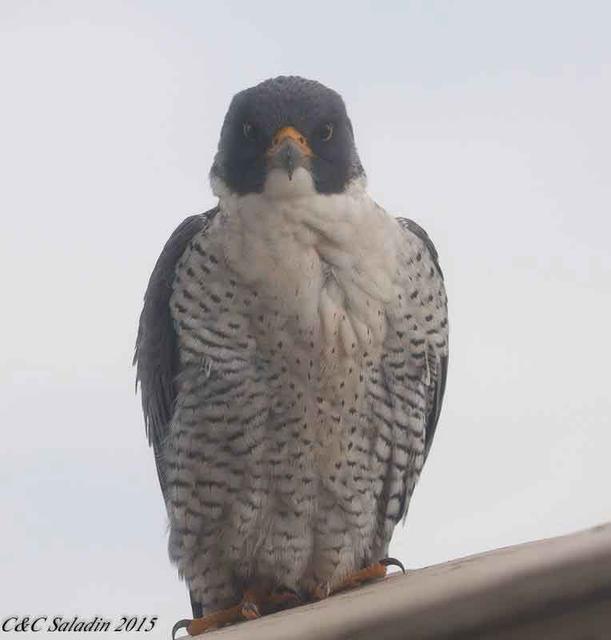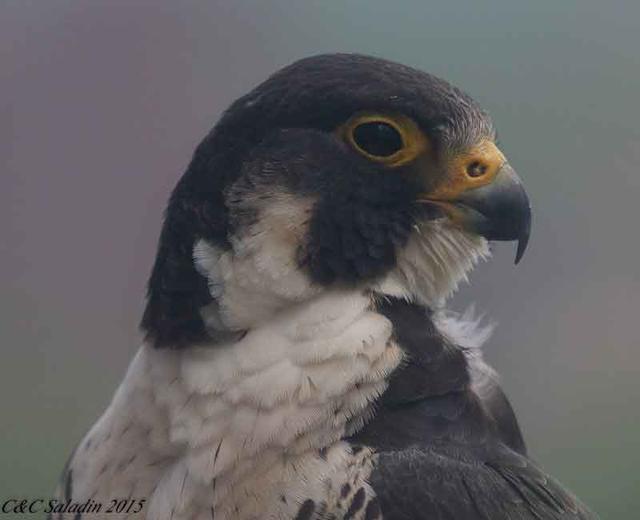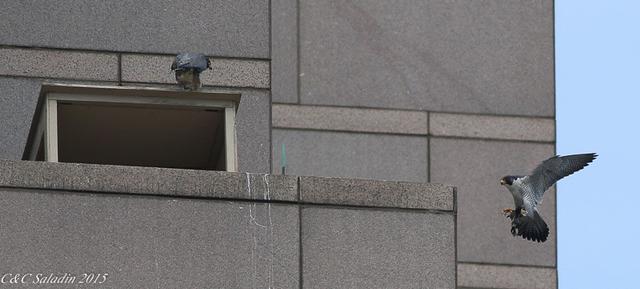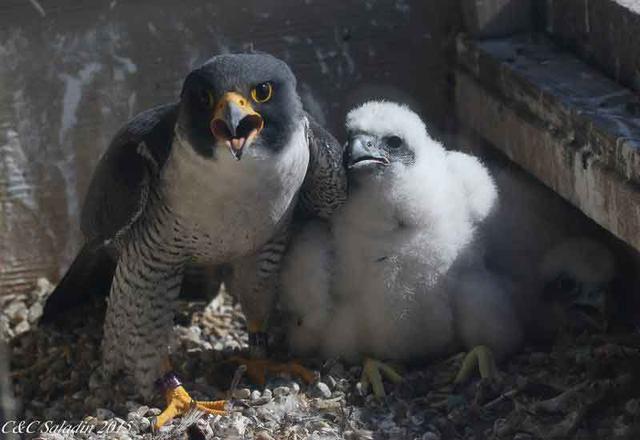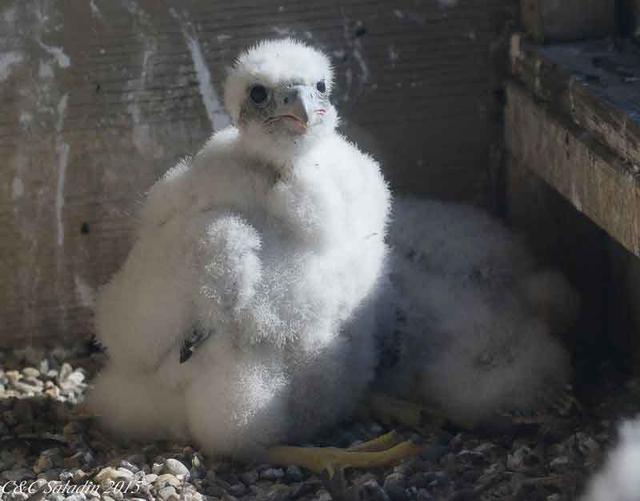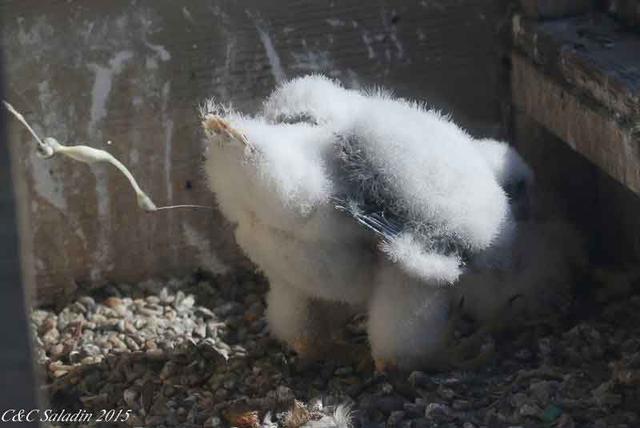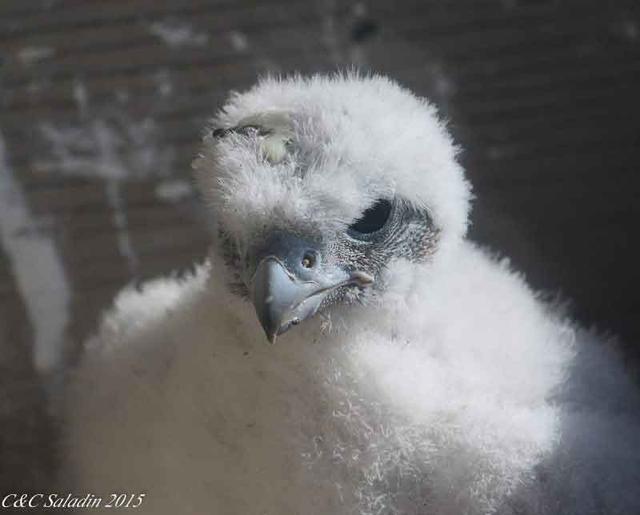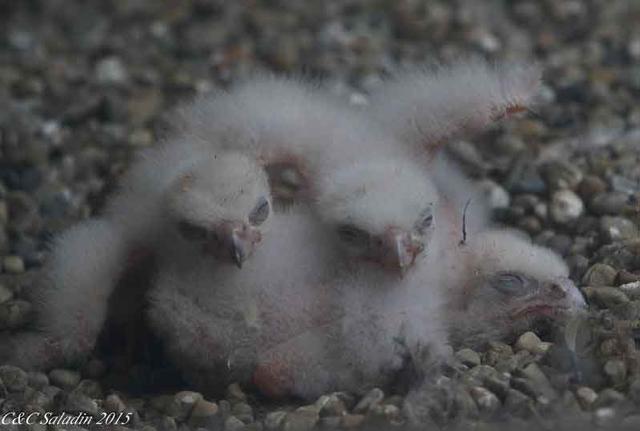FALCON FLASH
Dateline: Cleveland, Ohio
May 26, 2015
Click here to read what happened earlier
They are moving around their nestbox a bit, but stay within its safe boundaries. Mrs. Saladin tells us, “Prior to walking on their feet (at about 2 1/2 to 3 weeks) they scoot around on their tarsi (legs), so they aren't going very far”. Mrs. S thinks this eyas might be a female. Check out her tarsi.
It is with great sadness that we have to report that the little eyas has disappeared from the ledge and we assume it has died. Here is what happened:
On Friday morning, falcon fans were watching the FalconCams. All seemed to be normal at 9:00 a.m. and Newton was feeding the eyas, but a few minutes later, the eyas vanished from the FalconCam pictures. Apparently, the little one was just taking its first wobbly steps and fell over the edge of the nestbox. Laura Graber of the Ohio Division of Wildlife tells us, “We are not exactly sure what happened, except the chick fell out of the tray. It was in a spot between the wall and the tray, but the adults still could get to it. Newton did feed it when it was there, but she did not brood it overnight. The chick was gone the next morning. We are speculating that something health wise might have been wrong with the chick and the adults knew it”.
It is a falcon fact, that the first few years of life are the most dangerous, and some peregrine young die within their first few years. Many bird species occasionally lose youngsters who fall out of their nest. Even more dangerous is when a young peregrine falcon learns to fly and accidents occur because an inexperienced young falcon flies so fast. Sometimes, a chick is just not healthy.
It is also a fact of nature that each year most falcon families have an average of 3-4 chicks. That means if some don’t survive, there will be others to carry on for the species. Although we are sad to see one chick die, keep in mind that almost all peregrine falcons had vanished from North America just 4 decades ago due to the use of the pesticide DDT. It caused eggshells to be so fragile that the eggs would break and the chicks inside the eggs would die. Thanks to humans realizing what was happening and banning DDT, the species was able to recover from near extinction. Newton is the mother of many sons and daughters over her 14 year life. Nearly each year of her adult life, she has successfully laid eggs and raised her many offspring. She is one of the mother falcons that has helped the species peregrine falcon recover to healthy numbers.
In nature, survival of a species is all important, and there are other falcon families living not too far away from Newton and Boomer’s nestsite. Mr. and Mrs. Saladin monitor another nest at the world famous Cleveland Clinic, and at that nestsite there are currently 3 healthy chicks. Here they are at 5 days old.
Ely and Dipper’s eyasses were hatched earlier than Newton and Boomer’s, and they are now nearly 3 weeks old. Yikes, look how big they are!
In the following picture you can see the family’s nestbox with Ely perched on top of it and Dipper arriving with prey.
In this family, Dipper is the father falcon. In the following picture, Dipper looks through a window at Mr. and Mrs. Saladin, who explain, “These windows feature one-way glass, so even though the pair sometimes sees and reacts to movement and shadows from inside, they are mostly unaffected by window watchers”.
We will watch Ely and Dipper’s family, but let’s remember Newton, Boomer and their lost little one and honor them for their contribution to their species - even though it is hard for us to understand Nature’s way.
When humans have an accident we can call 911, but in nature that cannot happen. It is called “survival of the fittest”, which means that the very strongest and most successful individuals are the ones that survive to
make the species strong. We can celebrate the lives of Newton, Boomer and their little one by knowing that their species will continue to grow and be strong as we watch their neighbors, Ely, Dipper and their 3 eyasses.
The cycle of life continues.
Stay tuned for falcon news.
The pictures are courtesy of volunteer peregrine nest monitors, Mr. and Mrs. Saladin.
Ely is the mother falcon.
Mrs. S continues, “Because males develop faster than females we will start to see males progress not only in appearance (with the pin feathers showing and losing down more quickly), but also in activity level (movement and flapping and as they progress running and "taxiing" on the ledges). Their genders will
become more obvious (although we won't have a banding here to confirm leg width and the fit of male vs. female bands) as they continue to progress, as current overall size differences and development could still be accounted for by hatch order to some degree”. Mrs. S thinks this might be a male who is already showing some pin feathers……
Yes, he is also doing a frequent activity. Usually, the stream is projected out of the nestbox, but this guy hit his sibling. Hmmmm, on purpose? How do you think it likes its new hair gel?????
Click here to read what happened next

